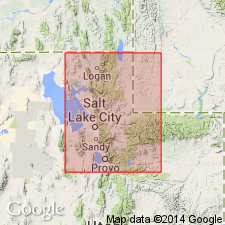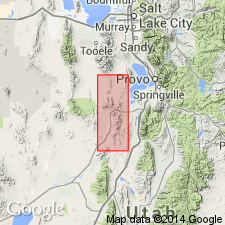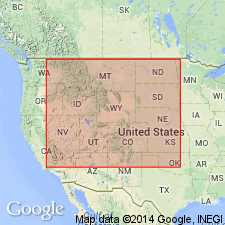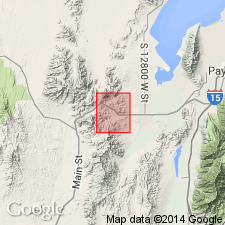
- Usage in publication:
-
- Fitchville formation*
- Modifications:
-
- First used
- Dominant lithology:
-
- Dolomite
- AAPG geologic province:
-
- Wasatch uplift
Summary:
First published use as a stratigraphic unit in the Oquirrh Mountains and Provo area, Utah Co, UT on the Wasatch uplift. Rocks assigned to Fitchville in this report were formerly thought to be Devonian and were called Jefferson? Dolomite. Unconformably overlies Ophir Shale at some localities and Maxfield Limestone at others. Basal 1 to 10 ft is a yellowish-weathering limy siltstone to well-cemented quartzite unit that has scattered spherical, frosted grains of quartz and pebbles up to one-inch diameter. The overlying lower part of Fitchville is a light-gray, medium-grained dolomite. The upper part is coarser-grained dark gray dolomite. Both parts have vugs referred to by miners as "eye beds." Upper contact placed at top of a bed or of several beds of pale-gray to white-weathering, massive, fine-grained dolomite that weathers to a distinctive grooved appearance. Thickness not stated. Regarded as Early Mississippian on basis of sparse coral assemblage. Correlation chart. Cross section.
Source: GNU records (USGS DDS-6; Denver GNULEX).

- Usage in publication:
-
- Fitchville formation*
- Modifications:
-
- Named
- Dominant lithology:
-
- Limestone
- AAPG geologic province:
-
- Wasatch uplift
Summary:
Named for exposures on Fitchville Ridge, a short spur that separates Gardner and Eagle Canyons on north slope of Eureka Ridge, T10S, R2W, Utah Co, UT on Wasatch uplift. Type locality measured on the ridge in NE1/4 NW1/4 sec 19, T10S, R2W where 280+ ft are present conformably above Pinyon Peak limestone and conformably beneath Gardison limestone (new). Replaces Gardner dolomite in part, a name abandoned. Base placed at base of a sand-streaked limestone 8-to l2-inch thick bed, known as the sand grain marker. Upper contact placed at top of an 18-to 24-inch wavy laminated limestone known as the curly limestone. Exposed in main Tintic district and in south-central part of East Tintic Mountains. Consists of medium- to dark-gray, fine-, medium- to coarse-grained limestone. Is about 335 ft thick on Greeley Hill, 6 mi east of type. Fossils (corals, syringoporas, brachiopods) date Fitchville as Early Mississippian. Probably correlates with Lodgepole limestone and Leatham formation. Geologic map. Cross sections.
Source: GNU records (USGS DDS-6; Denver GNULEX).

- Usage in publication:
-
- Fitchville Formation*
- Modifications:
-
- Overview
- AAPG geologic province:
-
- Great Basin province
Summary:
Divided by a previously unrecognized unconformity into two parts--a Devonian and a Mississippian part. Is 26 m thick and of Late Devonian, Famennian age at the Mowitza Mine, Star Range, Beaver Co, UT in the Great Basin province and in the Lower BISPATHODUS COSTATUS zone. Is 55+ m thick and of Late Devonian, Famennian and Early Mississippian, Kinderhookian age near Eureka in East Tintic Mountains, Juab Co, UT in the Great Basin province where it is in the Lower BISPATHODUS COSTATUS (Famennian) to SIPHONODELLA SULCATA, S. SANDBERGI, and Lower SIPHONODE. Some rocks formerly assigned to Topache Limestone are reassigned to the Fitchville.
Source: GNU records (USGS DDS-6; Denver GNULEX).

- Usage in publication:
-
- Fitchville Formation*
- Modifications:
-
- Age modified
- AAPG geologic province:
-
- Great Basin province
Summary:
Age of the Fitchville Formation is Late Devonian and Early Mississippian.
Source: GNU records (USGS DDS-6; Menlo GNULEX).
For more information, please contact Nancy Stamm, Geologic Names Committee Secretary.
Asterisk (*) indicates published by U.S. Geological Survey authors.
"No current usage" (†) implies that a name has been abandoned or has fallen into disuse. Former usage and, if known, replacement name given in parentheses ( ).
Slash (/) indicates name conflicts with nomenclatural guidelines (CSN, 1933; ACSN, 1961, 1970; NACSN, 1983, 2005, 2021). May be explained within brackets ([ ]).

